With its ability to support exponential growth in data transmission across distance over the past 15+ years, coherent optical technology, or coherent optics, is a key contributor to today’s modern communications infrastructure.
A look back
Before the advent of coherent optics, long-distance data transmission relied on noncoherent or intensity-modulated direct detect (IM-DD) technology. IM-DD uses the amplitude of the signal to encode/decode information with a simple photo detector (the receiver) to measure its power. For example, light on = 1, light off = 0. This technology is the foundation of 10 Gb/s DWDM systems, which were state of the art in the early 2000s.
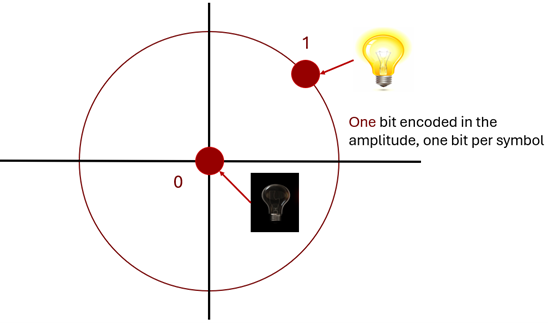
Figure 1. Example of IM-DD technology
Essential terms to know
- Baud, or symbol rate, refers to how many symbols or signaling instances are processed per second
- A symbol consists of 1 or more bits
- The baud combined with the number of bits/symbols determines the achievable wavelength capacity
- Example: For 10 Gb/s: 11 GBaud * 1 bit/symbol = 10 Gb/s plus overhead (used for FEC and other functions)
- Spectral efficiency refers to how efficiently optical spectrum is used and is measured by calculating the usable data throughput divided by the spectrum required by the optical signal
- Example: 10G systems have spectral efficiency of 0.2 bits/sec/Hz (10 Gb/s divided by
50 GHz)
- Example: 10G systems have spectral efficiency of 0.2 bits/sec/Hz (10 Gb/s divided by
Increasing the baud / symbol rate is a common way to increase wavelength throughput and scale networks. In the mid-2000s, however, the industry realized that pushing symbol rates beyond 10 GBaud with IM-DD while compensating for fiber impairments—such as chromatic dispersion (CD) and polarization mode dispersion (PMD)—was becoming increasingly challenging and resulted in brittle solutions.
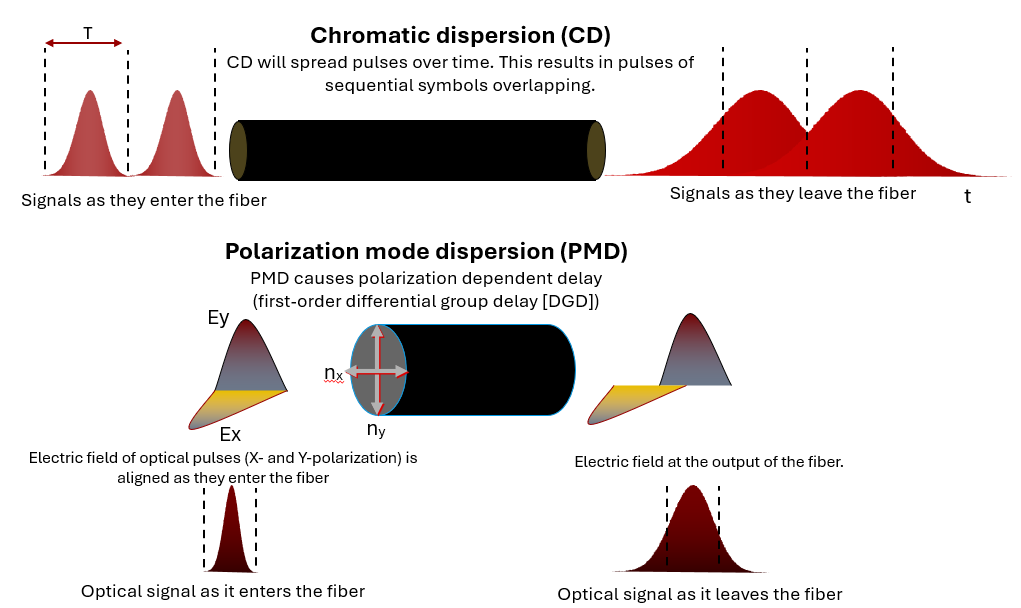
Figure 2. CD and PMD
At this time, advances in integrated electronics and photonics made it possible to apply digital signal processing (DSP) to optical signals for the first time. In 2005, Ciena scientists and engineers (Nortel at that time) started commercial shipments of the industry’s first electronically compensating 10 Gb/s solution that precompensated for CD. This technology significantly changed how optical networks could be built as it eliminated the need for dispersion slope compensation modules (DSCMs) from the network.
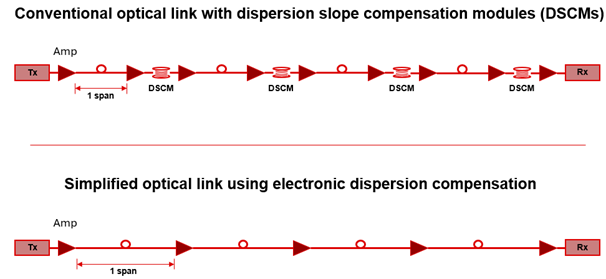
Figure 3. Networking impact of electronic dispersion compensation
This technology, the first generation of Ciena’s WaveLogic™ brand, was the precursor to commercial coherent optical systems. After developing the first integrated analog-to-digital converter, a seminal development in the industry, Nortel announced the first commercial coherent optical transmission system in March 2008. The modems connecting this system, powered by an advanced application-specific integrated circuit (ASIC), used DSP techniques at the receiver to compensate for linear channel impairments such as chromatic and polarization mode dispersion. They also detected symbols in four dimensions, enabling 40 Gb/s transmission per wavelength at 10 GBaud. These early modems delivered four times the capacity of 10 Gb/s DWDM systems, using widely available 10 GBaud components, and still fit into existing 50 GHz–gridded photonic line systems. Now, almost two decades later, the latest generation of coherent modems can transmit 40 times more capacity, or 1.6 Tb/s on a single wavelength across hundreds of kilometers, harnessing cutting-edge developments spanning optics and electronics.
Want to learn more about how coherent technology was born? Read the article.
From one dimension to many: The coherent optics advantage
How exactly does coherent optics help with scaling capacity in networks? First, and most importantly, coherent detection unlocks additional orthogonal dimensions that can be used for data transmission. While IM-DD uses only amplitude for information encoding/decoding, coherent detection uses amplitude, phase, and polarization dimensions.
Coherent detection uses a laser at the receiver, called the local oscillator, to tune into the frequency of interest, and can decode information in both amplitude and phase dimensions. Various modulation schemes can then be used, which increase the bits per symbol in the capacity equation. Moreover, coherent signals can be transmitted and received across both horizontal and vertical polarizations, further doubling the transmission capacity. The first coherent solution, implementing dual polarization quadrature phase shift keying (DP-QPSK) modulation, unlocked four times more capacity compared with 10 Gb/s systems.
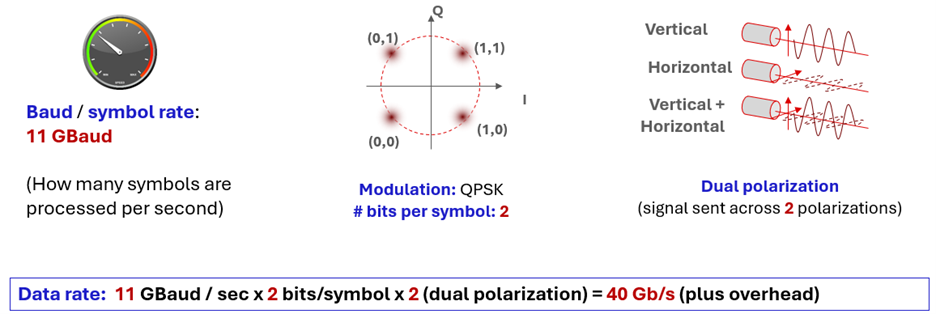
Figure 4. Example of achieving 4 x capacity with coherent technology
Another benefit of coherent detection is the ability to improve the signal-to-noise ratio by using a high-power local oscillator. The receiver sensitivity—the power at which a predetermined bit rate can be reliably received—is much lower for coherent detection, which translates to longer unregenerated signal reach.
Finally, coherent receivers recover the full optical field, allowing the receiver to easily correct for any linear impairments along the fiber link, which are difficult to compensate for in IM-DD systems. For example, CD is a linear impairment that coherent systems can fully compensate digitally but that poses significant challenges in IM-DD systems. This flexibility offered by ASIC-based DSP allows signals to be equalized over a wide variety of links, satisfying the demands of fiber networks with varying characteristics and performance levels. Equally important, designing and deploying new optical networks became much simpler as optical compensation modules for dispersion management—and the manual engineering associated with these—were eliminated.
An evolving technology
The technology has advanced considerably since the first commercial deployments of coherent optical systems in 2008. Over the past 15+ years, capacity per wavelength has increased 40-fold, while power efficiency (watts/bit) has improved by more than 95%.
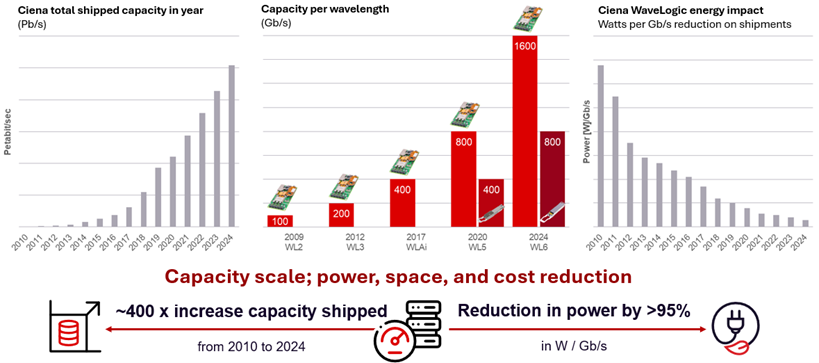
Figure 5. Benefits of coherent technology innovation
These gains were driven by many innovations.
One of the most important contributors of coherent system scaling has been shrinking transistor size and the corresponding increase in computational efficiency from advances in semiconductor device fabrication. Powerful custom ASICs resulting from these innovations have been carefully integrated with high-bandwidth electro-optics to scale the information-carrying capacity of a single modem, which has roughly doubled every four years. Improvements in integrated photonic platforms—like silicon photonics and indium-phosphide—have enhanced the integrability and efficiency of coherent modems.
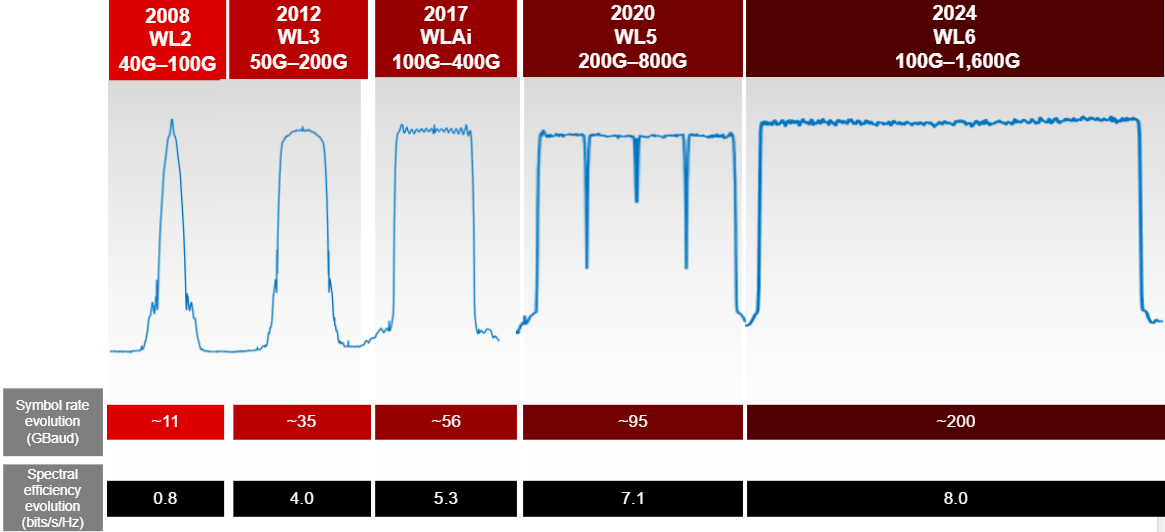
Figure 6. Examples of coherent technology generations and evolution
Along with hardware innovations, new DSP techniques have been developed. The latest coherent modems boast probabilistic constellation shaping (PCS) and variable baud and line rates, so the information rate can be finely tuned to match the capacity of a given fiber link. Transmitter precompensation and frequency-division multiplexing help mitigate optical nonlinearity on particularly long or challenging links. And developments in forward error correction (FEC) and clock recovery have pushed the noise tolerance and spectral efficiency of coherent modems even higher. As an example, WaveLogic 6 Extreme coherent modems, based on the 3 nm CMOS node, can transmit 1.6 Tb/s on a single-carrier wavelength over 700 km in commercial routes. They also decrease the space and power per bit by 50% and increase spectral efficiency by 15% compared with WaveLogic 5, introduced just four years earlier.
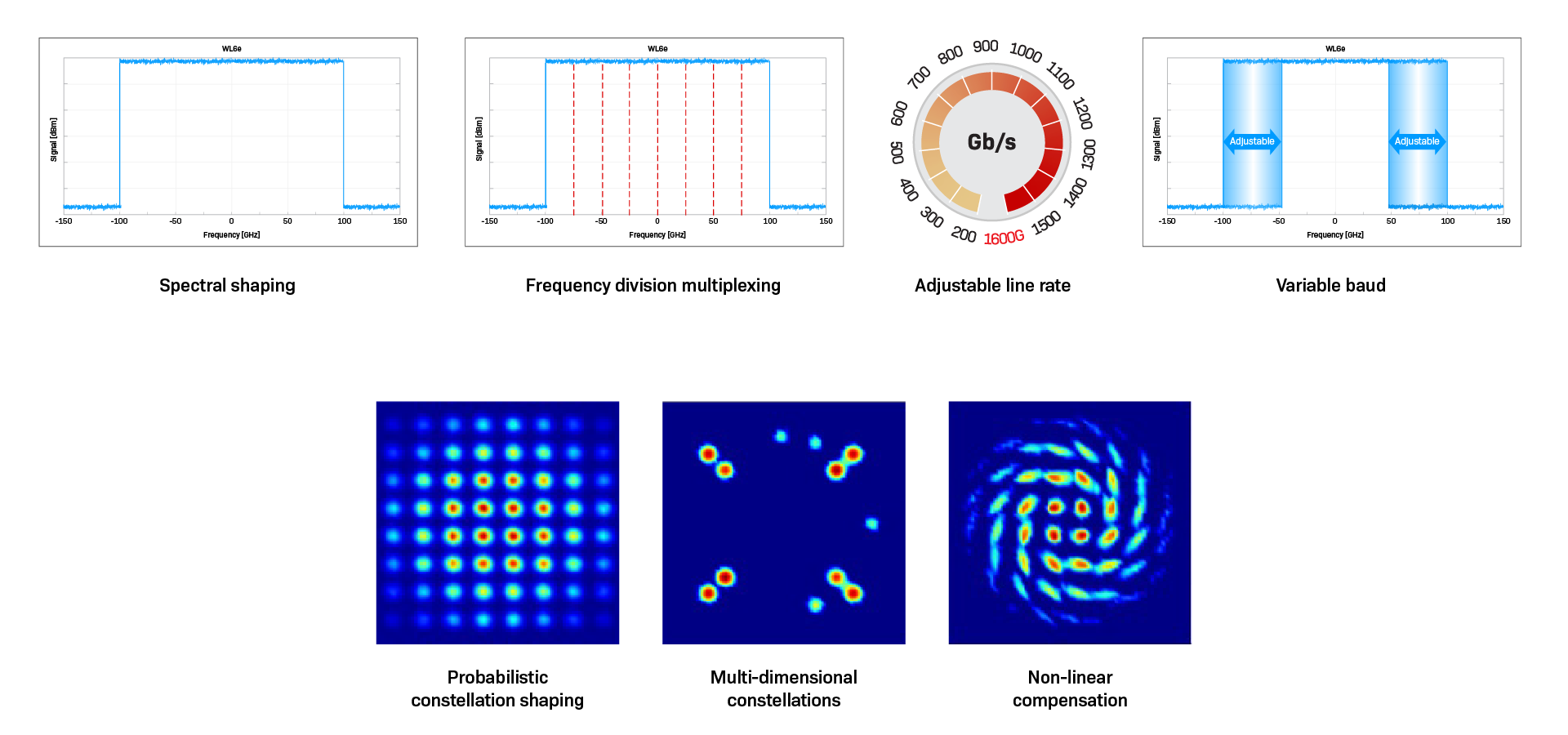
Figure 7. Examples of coherent DSP innovation
How coherent technology is shaping the future of networks
Coherent technology was initially deployed in long-haul and submarine networks, then expanded into metro and regional infrastructure. Around 2017, hyperscalers started building their own optical networks, and the use of coherent optics was widely adopted for data center interconnect (DCI) across <100 km, an application typically serviced by IM-DD technology, to support massive capacity requirements. Through continued advancements in both CMOS and electro-optic miniaturization, in the early 2020s, power-optimized coherent designs were developed to deliver high-capacity connectivity within standard-compliant pluggable form factors such as QSFP-DD. This achievement led to direct integration of coherent optics in routers, enabling further network simplification and massive volume deployments of coherent pluggable transceivers for single-span DCI applications.
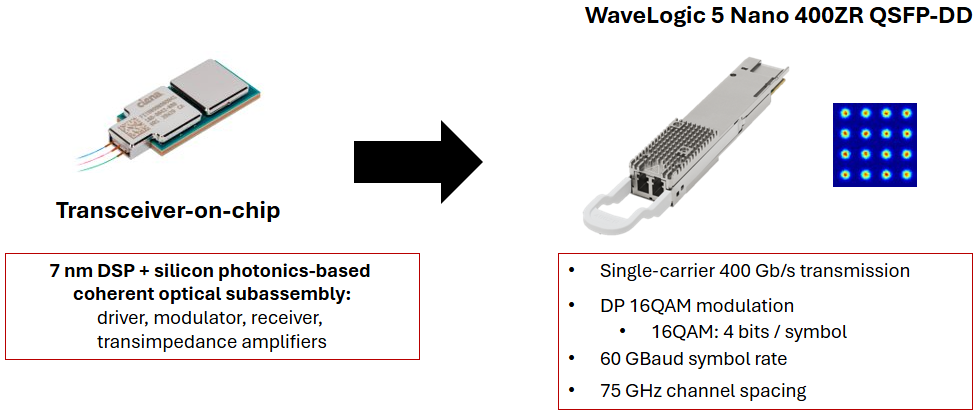
Figure 8. Example of 400ZR coherent pluggable transceiver
As optical noncoherent line rates continue to increase, IM-DD is starting to encounter the same technical challenges in datacom applications as it did over a decade ago in the WAN. The transition to coherent optics for shorter links—around 10 km or less—is underway with the development of Coherent-Lite pluggable transceivers. These transceivers incorporate the improved capacity and receiver sensitivity of coherent detection with simpler electro-optics and reduced DSP functionality. Features such as limited dispersion compensation and simpler hard-decision FEC help reduce power consumption and latency.
Coherent optical transmission will keep pushing toward higher capacities, lower costs per bit, and greater spectral efficiency for both long- and short-reach links. Once limited to long-haul routes hundreds or thousands of kilometers long, it is now entering a new phase. The rapid growth of hyperscale data centers—driven by AI applications—is creating massive demand for connectivity. In response, coherent optics will inevitably extend into the data center, not as a possibility but as a necessity. What began as a long-haul breakthrough is now evolving into a universal enabler of connectivity, with its arrival inside the data center a matter of when, not if.

Figure 9. Coherent optics application spaces
Discover more about coherent optics. Read the article.




